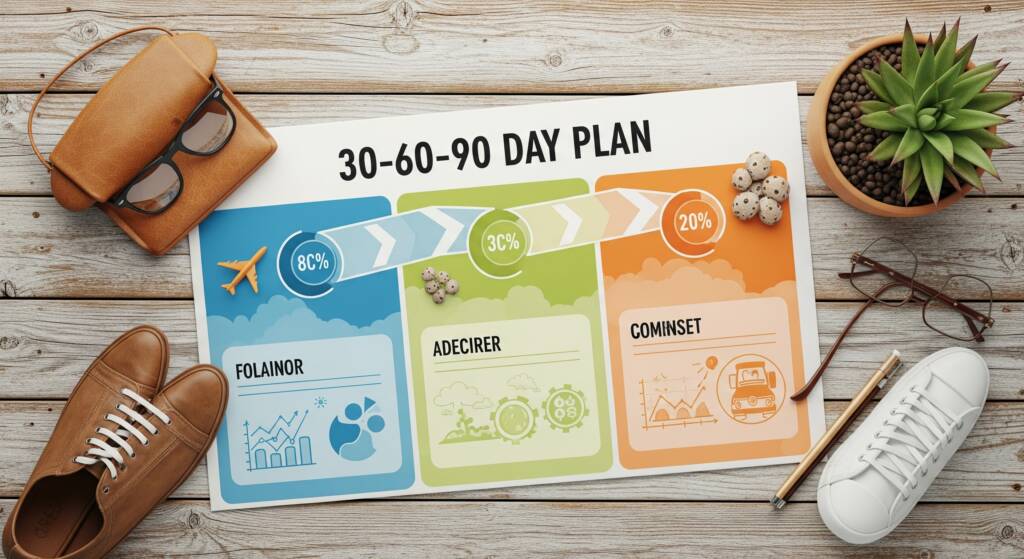Remember when planning a trip used to involve going to an agency or spending hours flipping through paper guidebooks? Today, just ask an AI like ChatGPT or Perplexity, and you have a personalized itinerary in seconds. We are entering the era of connected travel, and artificial intelligence (AI) is the engine transforming the entire travel experience, from inspiration to the journey home.
A historic opportunity for the tourism sector
Experts like Bret Taylor (chairman of OpenAI and CEO of Sierra) compare this moment to the birth of the internet or smartphones: we are at a tipping point where AI “agents” and voice/multimodality become the natural interface for travel. The first to adopt it sets the standard.
In addition, recent Amadeus reports highlight that generative AI, autonomous agents, and biometrics are already being applied in airlines, airports, and hotels to eliminate friction and enable new models for selling and distributing travel services.

Real use cases: AI already travels with us
AI is no longer a promise, but a travel companion for the entire ecosystem: it inspires destinations when you still have doubts, builds itineraries in minutes, attends to you 24/7, and anticipates incidents before you see them. In hotels, it enables mobile keys and express check-in. In activities, it suggests plans tailored to your context. In ground transportation, it optimizes routes and schedules. And in destinations, it acts as a digital concierge, accompanying you from start to finish.
These are not prototypes: they are solutions in production that reduce friction, elevate the experience and open up new revenue streams. Here are concrete examples-from inspiration to “day of travel”-that are already working.
- Personalized planning: assistants such as ChatGPT or Perplexity help transform “vague ideas” into concrete itineraries; in fact, industry data shows that a large portion of travelers start planning without a fixed destination, ideal ground for AI inspiration.
-
24/7 omnichannel service: chatbots and voice agents resolve doubts on the web, app, WhatsApp or phone (policies, changes, schedules), offload call centers, and improve NPS in hotels, agencies, and rent-a-cars.
-
Cross-sell/upsell: hotels offer late checkout, spa services, or upgrades; OTAs and tour operators package local experiences; mobility and rent-a-car services offer insurance, seats, or add-ons at the right time.
-
Smooth access and operations: check-in with biometrics or kiosks, mobile keys and self-service at reception; in mobility, dynamic fleet and route assignment; in museums/attractions, real-time queue and capacity management.
-
Destination experience: smart guides suggest what to see and where to eat based on weather, crowds and your tastes; self-configuring itineraries, instant translation and multilingual support for a frictionless stay.
-
Smart payments and loyalty: integrated wallets and one-click payments; programs that use AI to recognize habits (business/leisure), personalize benefits, and increase repeat business.
The connected journey: from point to point, frictionless
The vision of connected travel is to integrate all stages (inspiration → booking → airport → flight → hotel → destination → return) with a “virtual concierge” that anticipates needs. To achieve this, interoperability between airlines, airports, hotels, and OTAs is needed.
A milestone: in May 2025, Finnair became the first airline to create a “native order” with Amadeus technology, unifying customer services under a single digital record (flight, baggage, seats, lounges, transfers). The technical basis for reacting automatically when something changes.

Challenges (with reality ahead)
But getting started has certain implications: Among others:
- Legacy systems and silos: without modernization and interoperability, AI gets “stuck” in isolated pilots when data is not centralized or we do not have a single view of our customer.
- Privacy and trust: biometrics and sensitive data require security, transparency and optionality for the traveler.
- Do not lose the human touch: AI frees staff to focus on what brings emotional value; empathy remains a differential advantage. Keep in mind that it is a facilitator but if the user wants it, he should always be able to “talk” to a human being.
- Sustainability: AI can optimize routes and energy, but it also has a digital footprint for its operation; benefits and consumption must be balanced.
How to get started in 90 days (practical roadmap)
Going from ideas to results does not require a “big bang”; instead, it requires short, measurable, and focused steps. In 90 days, you can validate the AI value proposition in travel if you choose the right cases, align a minimum team (business + operations + data + legal), and work with weekly iterations. The key is to start with high-volume cases (frequently asked questions, simple changes, proactive alerts) that will give you a quick impact and real learning about your customers.
Think of this roadmap as a lab that will allow you to perform a quick test.
Day 0-30: Discovery and fast pilots
Choose 3-5 use cases (FAQ, simple changes, notices).
Launch a minimum viable product(MVP) wizard (web/app/WhatsApp/voice) with. RAG on your policies.
Connects 1-2 APIs (reservation/status/client) for basic queries and modifications.
Set baseline KPIs (self-service, AHT, CSAT, attach rate, deviations to human).
Generates Guardrails from day 1: privacy/consent, diversion to human, traceability.
Day 31-60: Orchestration and enhancement.
Activate contextual offers (ancillary services with AI) at key moments: post-booking, check-in, pre-boarding/stay and day of travel.
Implements proactive alerts that impact service (schedule changes, door/gate, room status, table/experience availability, vehicle pickup).
Frictionless access and opt-in identity verification (depending on your vertical):
Hotels: mobile pre-check-in + digital key; remote document verification with consent.
Car rental: pick-up without counter (verified license + contract on mobile).
Attractions and tours: entrance with QR/Wallet and real-time capacity control.
Rail/Cruises: unified digital pass (ticket + extras) and fast boarding control.
Day 61-90: Scaling and quality
Extends cases to higher value/variability (rearrangements, bundles, special policies).
Chat payments to close upgrades and extras without leaving the stream.
AI quality improvement: A/B prompts, multilingual, observability (accuracy, fallbacks).
Responsible personalization (preferences + context with opt-in).
Operational and compliance: escalation playbooks, team training, data/risk audits and KPI updates for the next quarter.

Recommended technology
Think of your technology stack as an orchestra: each instrument plays a role, and the “baton” (the AI) coordinates everything so that the traveler feels a seamless experience. You don’t need to start with a full symphony; with a well-tuned quartet, you can play melodies that delight your customers.
Conversational AI layer: LLM with voice and multimodality (text, image, documents).
Content Manager/FAQs with RAG (so that the AI “reads” your policies and responds well).
Orchestration of offers for cross-selling).
Payment gateway integrated into the conversational flow in the channels you make available to your customers (chat, WhatsApp…).
Observability: quality dashboards (accuracy, hallucination rate), safety and satisfaction.
KPIs and ROI: what to measure and how to explain it in committee
AI is not “believed”; it is demonstrated with numbers. Before launching, set a baseline and define KPIs that align with business objectives, including self-service savings, ancillary conversion, time reduction, NPS/CSAT (Net Promoter Score-Customer Satisfaction Score) improvement, and incremental sales. It presents ROI in two areas: operational efficiency (lower cost per contact, lower AHT-Average Handle Time) and growth (more revenue per customer, more cross-sell).
When you take it to committee, tell the whole story: data → measurement → decision → outcome. Accompany the metrics with concrete customer examples and flow screenshots so that the value is clear and tangible, not abstract.
Self-service: % of queries resolved without human agent. Target: +20-40% in 90-120 days.
AHT (average handling time) and cost per contact: 20-35% reduction through automation.
Incremental sales: Increased cross-selling (upgrades, packs, coverages, skip the line, late check-out,)
CSAT/NPS: improvement in critical interactions.
Conversion: inspired → booking (especially in travelers without a defined destination).
Risk/Quality: response accuracy, escalation rate to human, security audits.
Trust and legal risks (quick checklist)
Keep communication simple and honest: “AI helps you, you decide”. Always offer alternatives (digital and paper; bot and human). This will gain legitimacy, reduce regulatory friction, and turn security into a competitive advantage.
Clear consent: explain what data you use (e.g., biometrics) and for what purpose, with an opt-out option.
Data governance: retention/anonymization policies and end-to-end encryption.
Traceability: records relevant automated decisions (why X was offered, why it was rearranged).
Recourse mechanism: easy to escalate to human and correct AI errors.
Communication: “AI helps you, but you decide”; simple language and alternative options (digital and paper).
Travel has always been a mix of dreams and logistics. AI takes care of the logistics to get you back to the dreams. If we connect data with empathy, processes with purpose and algorithms with people, travel stops being a chain of paperwork and becomes an orchestrated experience.
This is the time to move from curiosity to action. You don’t need to have it all figured out: just take the first step, measure, learn and improve. Because the future of tourism will not be written by those who talk the most about AI, but by those who put it at the service of unforgettable memories. Ready to design the next great trip?
Have a good week!
Interesting sources:: Amadeus – Connected Journeys (2025). | Amadeus – Nevio (modern retailing and order management). | Bret Taylor (Sierra/OpenAI) – vision on agents and voice. Expedia Group Partner – 60% starts with no destination (inspirational opportunity). | CivicScience – The stress of planning




